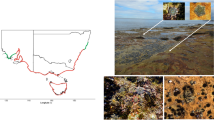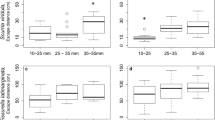Summary
1.Calliactis polypus in Hawaii and C. tricolor in Puerto Rico both respond to mechanical stimuli that resemble the activities of their commensal pagurids, e.g., stroking, tapping, scratching and squeezing of the column, by opening up, relaxing and loosening their pedal discs (Figs. 3–6).
2.C. polypus, which does not transfer to crabs unaided, could only be detached by lifting the pedal disc after the anemone had been subjected for some time to tactile stimuli very similar to those applied by Dardanus gemmatus (Figs. 1 and 2). C. tricolor, which can transfer to shells unaided by crabs and which lives on several hosts, can be relaxed and detached quickly by various substitutes, the most effective being gentle brushing around the base (Figs. 7–10).
3.Both species of Calliactis, when detached by such substitutes, were expanded and relaxed and retraction responses were inhibited. In this state tentacles and pedal discs adhered strongly to any solid surface and the anemones settled on these quickly (Figs. 11–14).
4.Electrical stimuli at low frequencies (maximum 1 pulse per sec at 27–29° C) cause extension and relaxation of the column. Usually after 40–50 stimuli release of the pedal disc occurs. The effective pulse frequencies are close to the frequency of the tactile contacts of crabs or substitutes which evoke the relaxation and release of C. polypus and C. tricolor (Figs. 15–18).
5.It is suggested that species with less restricted host relationships, in this case C. tricolor, are less restricted also in the kinds of stimuli that cause detachment. The role of sensory adaptation and the requirements of the neural organization controlling these activities are discussed. The excitation process is frequency-dependent and the response pattern is triggered at an appropriate level by summation. the detachment of C. polypus and C. tricolor is compared with the very slow detachment of C. parasitica in response to shells, and with the very rapid detachment of the swimming sea anemones, Stomphia and Actinostola. All of these anemones use different mechanisms to achieve the same end.
Similar content being viewed by others
References
Batham, E. J., Pantin, C. F. A.: Slow contraction and its relation to spontaneous activity in the sea anemone Metridium senile (L.). J. exp. Biol. 31, 84–103 (1954).
Brock, F.: Das Verhalten des Einsiedlerkrebses Pagurus arrosor Herbst während des Aufsuchens, Ablösens und Aufpflanzens seiner Seerose Sagartia parasitica Gosse. Wilhelm Roux' Arch. Entwickl.-Mech. Org. 112, 205–238 (1927).
Cutress, C., Ross, D. M.: The sea anemone Calliactis tricolor (Lesueur) and its association with the hermit crab Dardanus venosus (H. M. Edwards). J. Zool. (Lond.) 158, 225–241 (1969).
- - Sutton, L.: The associations of Calliactis tricolor and its pagurid, calappid and majid partners in the Caribbean. Canad. J. Zool. (in press) (1970).
Ellis, V., Ross, D. M., Sutton, L.: The pedal disc of the swimming sea anemone Stomphia coccinea during detachment, swimming and resettlement. Canad. J. Zool. 47, 333–342 (1969).
Ewer, D. W.: Inhibition and rhythmic activity of the circular muscles of the sea anemone Calliactis parasitica (Couch). J. exp. Biol. 37, 812–831 (1960).
Josephson, R. K.: Neuromuscular transmission in a sea anemone. J. exp. Biol. 45, 305–319 (1966).
Pantin, C. F. A.: The nerve net of the Actinozoa. I. Facilitation. J. exp. Biol. 12, 119–138 (1935a).
—: The nerve net of the Actinozoa. II. Plan of the nerve net. J. exp. Biol. 12, 139–155 (1935b).
—: The nerve net of the Actinozoa. III. Polarity and after-discharge. J. exp. Biol. 12, 156–164 (1935c).
Passano, L. M., Pantin, C. F. A.: Mechanical stimulation in the sea anemone Calliactis parasitica. Proc. roy. Soc. B 143, 226–238 (1955).
Robson, E. A.: Swimming in Actiniaria. Symp. Zool. Soc. London 16, 333–360 (1967).
Ross, D. M.: Quick and slow contractions in the isolated sphincter of the sea anemone, Calliactis parasitica. J. exp. Biol. 34, 11–28 (1957).
—: Behavioural and ecological relationships between sea anemones and other invertebrates. Oceanogr. Mar. Biol. Ann. Rev. 5, 291–316 (1967).
- The commensal association of C. polypus and the hermit crab Dardanus gemmatus in Hawaii. Canad. J. Zool. (in press) (1970).
—, Sutton, L.: The response of the sea anemone Calliactis parasitica to shells of the hermit crab Pagurus bernhardus. Proc. roy. Soc. B 155, 266–281 (1961).
—: The swimming response of the sea anemone Stomphia coccinea to electrical stimulation. J. exp. Biol. 41, 735–749 (1964).
—: The response to molluscan shells of the swimming sea anemones Stomphia coccinea and Actinostola new species. Canad. J. Zool. 45, 895–906 (1967).
—: Detachment of sea anemones by commensal hermit crabs and by mechanical and electrical stimuli. Nature (Lond.) 217, 380–381 (1968).
Sund, P.: A study of the muscular anatomy and the swimming behaviour of the sea anemone, Stomphia coccinea. Quart. J. micr. Sci. 99, 401–420 (1958).
Yentsch, C. S., Pierce, D. C.: A swimming anemone from Puget Sound. Science 122, 1231–1233 (1955).
Author information
Authors and Affiliations
Additional information
We acknowledge the help we received from the following: the Director of the Oceanic Institute, Waimanalo, Hawaii (Dr. John Hendrickson) and the Director of the La Parguera Laboratory of the University of Puerto Rico at Mayagüez (Dr. Maxime Ceramé-Vivas); Dr. Ernst Reese and Mr. John Talis in Hawaii and Dr. Charles Cutress and Dr. Luis Almodovar in Puerto Rico, who arranged for the collection of animals and who assisted us in many other ways; the National Research Council of Canada through Operating Grant A-1445.
Rights and permissions
About this article
Cite this article
Ross, D.M., Sutton, L. The detachment of the commensal sea anemones, Calliactis polypus and C. tricolor by mechanical and electrical stimulation. Z. Vergl. Physiol. 67, 102–119 (1970). https://doi.org/10.1007/BF00298122
Received:
Issue Date:
DOI: https://doi.org/10.1007/BF00298122




